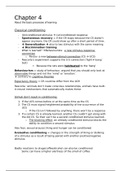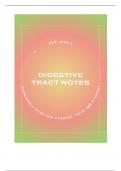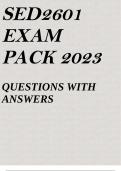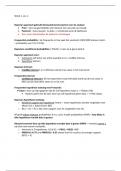Chapter 4
About the basic processes of learning
Classical conditioning
- (Un)conditioned stimulus (un)conditioned response
- Spontaneous recovery = if the CR stops because the CS doesn’t
appear anymore, the CR could show up after a short period of time.
- Generalization also to two stimulus with the same meaning
- Discrimination training
- What is learned? Behaviourists: a new stimulus-response
connection
o Pavlov: a new between-stimuli connection (CS UCS)
- Rescorla’s experiment supports the S-S connection (‘light bang’
test)
Because the rats were habituated to the ‘bang’
Behaviourism = study of behaviour, argued that you should only look at
observable things and not the ‘mind’ or ‘emotion’.
contrary to cognitive theories
Expectancy theory = CR could be differ from the UCR
Rescorla: ‘animals don’t make conscious relationships, animals have built-
in neural mechanisms that automatically makes these.
Stimuli don’t result in conditioning:
1. If the UCS comes before or at the same time as the CS
2. The CS must signal heightened probability of the occurrence of the
UCS
o If the CS isn’t followed by anything, there won’t be a response
3. If a certain CS is already learned, another CS couldn’t get along with
the old CS. So their can’t be a second conditioned stimulus learned.
o The blocking effect: an already conditioned stimulus blocks the
ability to condition a second stimulus
Also fear, sexual arousal, liking and hunger can be conditioned
Evaluative conditioning = changes in the strength of liking or disliking
of a stimulus as a result of being paired with another positive/negative
stimulus.
Bodily reactions to drugs/coffee/alcohol can also be conditioned
Some can have a higher alertness of the smell of coffee
, Drugs
Two effects:
1. A direct effect (the great feeling)
2. Compensatory reaction of the body
Only the compensatory reaction can be conditioned
(opposite to the drug effect)
Repeatedly being given a drug (morphine) gives two effects
when after a while no more drug is given, only the second reaction
shows up
This is because we can only condition responses that are reflexive.
The first effect of the drug isn’t a reflex, the second one is.
Drug tolerance = the decline in physiological and behavioural effects
that occur with some drugs when they are taken repeatedly.
this is due to condition, because the body has a compensatory reaction
before taking the drug, which countereffects the effects of the drug
In this way, it could be dangerous to use drugs in an other environment
(no reflex 2)
Operant conditioning
We response not only to stimuli, but also for stimuli.
Operant responses = responses that operate on the world to produce some
effect.
These responses are learned by: operant conditioning
Operant conditioning = a learning process by which the effect of a response influences the
future rate of production to that response.
Focused on non-reflective learning
Thorndike puzzle box with cats trial-and-error reduced time each
trial
Law of effect = responses that produce a satisfying effect in a
particular situation become more likely to occur again in that situation,
and responses that produce a discomforting effect become less likely to
occur again in that situation.
Skinner: a behaviourist (so doesn’t study mental events)
Reinforcement instead of ‘reward’ or ‘satisfaction’
Because this makes no assumptions about anything in the
mind
Some were conditioned reinforcements
About the basic processes of learning
Classical conditioning
- (Un)conditioned stimulus (un)conditioned response
- Spontaneous recovery = if the CR stops because the CS doesn’t
appear anymore, the CR could show up after a short period of time.
- Generalization also to two stimulus with the same meaning
- Discrimination training
- What is learned? Behaviourists: a new stimulus-response
connection
o Pavlov: a new between-stimuli connection (CS UCS)
- Rescorla’s experiment supports the S-S connection (‘light bang’
test)
Because the rats were habituated to the ‘bang’
Behaviourism = study of behaviour, argued that you should only look at
observable things and not the ‘mind’ or ‘emotion’.
contrary to cognitive theories
Expectancy theory = CR could be differ from the UCR
Rescorla: ‘animals don’t make conscious relationships, animals have built-
in neural mechanisms that automatically makes these.
Stimuli don’t result in conditioning:
1. If the UCS comes before or at the same time as the CS
2. The CS must signal heightened probability of the occurrence of the
UCS
o If the CS isn’t followed by anything, there won’t be a response
3. If a certain CS is already learned, another CS couldn’t get along with
the old CS. So their can’t be a second conditioned stimulus learned.
o The blocking effect: an already conditioned stimulus blocks the
ability to condition a second stimulus
Also fear, sexual arousal, liking and hunger can be conditioned
Evaluative conditioning = changes in the strength of liking or disliking
of a stimulus as a result of being paired with another positive/negative
stimulus.
Bodily reactions to drugs/coffee/alcohol can also be conditioned
Some can have a higher alertness of the smell of coffee
, Drugs
Two effects:
1. A direct effect (the great feeling)
2. Compensatory reaction of the body
Only the compensatory reaction can be conditioned
(opposite to the drug effect)
Repeatedly being given a drug (morphine) gives two effects
when after a while no more drug is given, only the second reaction
shows up
This is because we can only condition responses that are reflexive.
The first effect of the drug isn’t a reflex, the second one is.
Drug tolerance = the decline in physiological and behavioural effects
that occur with some drugs when they are taken repeatedly.
this is due to condition, because the body has a compensatory reaction
before taking the drug, which countereffects the effects of the drug
In this way, it could be dangerous to use drugs in an other environment
(no reflex 2)
Operant conditioning
We response not only to stimuli, but also for stimuli.
Operant responses = responses that operate on the world to produce some
effect.
These responses are learned by: operant conditioning
Operant conditioning = a learning process by which the effect of a response influences the
future rate of production to that response.
Focused on non-reflective learning
Thorndike puzzle box with cats trial-and-error reduced time each
trial
Law of effect = responses that produce a satisfying effect in a
particular situation become more likely to occur again in that situation,
and responses that produce a discomforting effect become less likely to
occur again in that situation.
Skinner: a behaviourist (so doesn’t study mental events)
Reinforcement instead of ‘reward’ or ‘satisfaction’
Because this makes no assumptions about anything in the
mind
Some were conditioned reinforcements







